How Do You Know Which Panel You Have Razer Blade
Display Analysis
Razer offers a wide array of brandish options on the Razer Blade 15, with the Base model having 2 choices, and the Advanced model offering three. On the Base, you lot can opt for a 1920x1080 144 Hz IPS panel that covers the sRGB gamut, which should adjust the RTX 3060 very well. Optionally, there is the 2560x1440 panel, offering a 165 Hz refresh rate and P3 gamut coverage, and as nosotros have just seen, it actually fits the RTX 3070'south operation profile well.
The Advanced model has a 360 Hz 1920x1080 sRGB panel, which is a lot of Hz. The QHD offering for the Advanced model is a 240 Hz panel, with sRGB gamut coverage, and crucially, Advanced Optimus which nosotros will become over presently. Finally, for those with lots of dollars to spend, and for those that love contrast ratios, Razer offers a UHD OLED display equally well, which is express to a lx Hz refresh charge per unit but does offer touchscreen functionality. For gaming, the other models with their higher refresh rates seem like a better fit, just OLED is always a visual stunner.
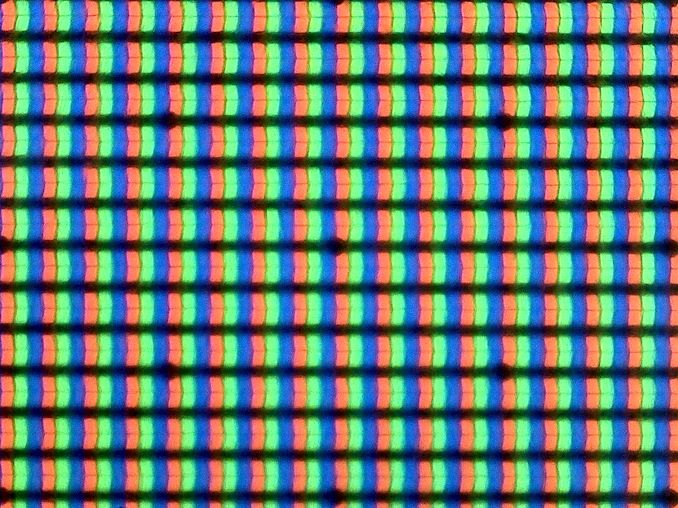 Razer Blade QHD Pixel Layout
Razer Blade QHD Pixel Layout
On all of their Blade laptops, Razer offers a born display multiplexer to let the customer to choose whether to run the display directly off the NVIDIA GPU or via the integrated Intel GPU, vis-à-vis NVIDIA's Optimus technology. If you are running off the battery, Optimus is the manner to go, but if you are running off Air-conditioning ability, directly connecting the GPU to the display will give the all-time performance and allow the display to be used at its high refresh charge per unit setting. That being said, the one exception to this is the Advanced model with the 240 Hz QHD panel, as that panel supports NVIDIA M-SYNC, and besides Advanced Optimus. Avant-garde Optimus brings all the benefits of the bombardment savings of Optimus, with G-SYNC support, and unlike the other models, does not crave the user to reboot the laptop when switching the multiplexer.
Razer let us know that even though they already include the software-switchable multiplexer, Avant-garde Optimus requires a Yard-SYNC panel also, and unfortunately the but Razer Blade 15 console choice with G-SYNC is the QHD 240 Hz offer. Consequently, all of the other models require a reboot to switch the display from iGPU to dGPU. That is very unfortunate, as the reboot is e'er a friction point. But at least Razer offers the multiplexer – giving users the option to switch over entirely to the dGPU – as many other devices do not.
Meanwhile it'due south worth noting that during the review the laptop was updated to the most recent NVIDIA GPU driver, which has a issues which prevents the dGPU from existence directly connected, resulting in a black screen on reboot. Razer and NVIDIA are both enlightened of this, and will consequence a corrected driver to fix information technology hopefully before long. In the mean time, we suggest that you do not update the GPU driver until this bug is resolved.
Let'due south talk about Gamuts
We've covered this a few times in the by, but information technology is still an issue in Windows 10 that can not be ignored. Razer offers ii brandish panels with P3-D65 gamut support (which they, like nearly companies, incorrectly characterization as DCI-P3 which is not applicable in the PC space, and has a different white point). And while you would think a wide-gamut display is going to be better, sadly, it is non. Windows 10 still has no meaningful arrangement-broad color management system, and as such, defaults to outputting all images equally if they were to be displayed on a sRGB brandish. That ways that unless you are using specific applications that handle color management, all colors volition exist diddled out on a P3 D65 display. Information technology is very unfortunate, as you would expect a P3 gamut to offer better color reproduction, as it can present more of the visible spectrum, but in near all cases, information technology volition be wrong. Proper desktop monitors with wide-gamut back up may offer 3D await-up tables to allow the user to switch from sRGB to P3 or AdobeRGB, but nearly no laptops offer this, including the Razer Blade 15.
Color Correction Correctness
One complaint we still have with likewise many laptops these days is that the display is not calibrated. Thankfully, Razer is providing individually calibrated displays on the Razer Blade 15, which is something to commend them on. But, there is a catch: Razor is using ICC color profiles at the OS-level to use their color correction.
As a bit of background, there are two means to ship calibration data with a display. The start is to test each brandish at the factory, then arrange the brandish'southward internal lookup tabular array (LUT) to output a colour-corrected paradigm. The second way is to utilize an ICC color profile on the display in software, which will do the same thing, but in software. The ideal way to do this is in hardware, as it is seamless for the finish user, and has the benefits of non causing crushing and banding artifacts than an excessive ICC profile tin cause. Also, non all applications support ICC profiles, and the color correction may just be ignored, depending on what is being run.
Razer for their part is using the software approach, and while that is notwithstanding a much better experience than not color correcting at all, information technology is not without its limitations. For instance, when setting the brandish to 200 nits of brightness, if the ICC contour is bypassed, the display effulgence is actually 240 nits. That is a significant difference, and it's because this item display is very heavily over-saturated on greenish, which then has to be clamped down on in software. The end result is the proper 200 nits with decent accurateness – and then the desired objective is achieved – but it comes at the cost of greater power usage by the display than what we'd encounter tweaking the brandish in hardware.
So, with that out of the style, here is how the Razer Blade 15's QHD display handled our display test suite. For reference, we use the X-Rite i1Display Pro colorimeter for effulgence and contrast measurements, and the X-Rite i1Pro two spectrophotometer for color accuracy testing. The Razer Bract 15 was tested at its native color gamut of P3 D65 using Portrait Displays' Calman software suite.
Brightness and Contrast
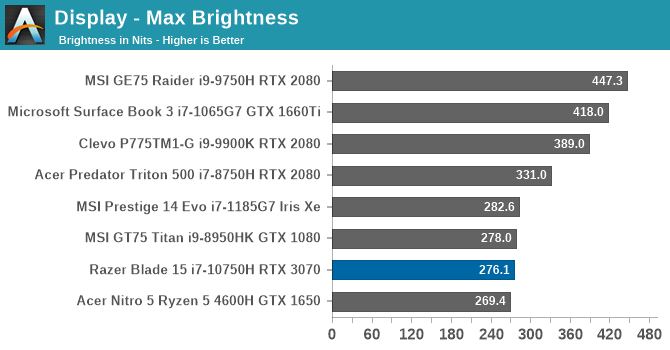
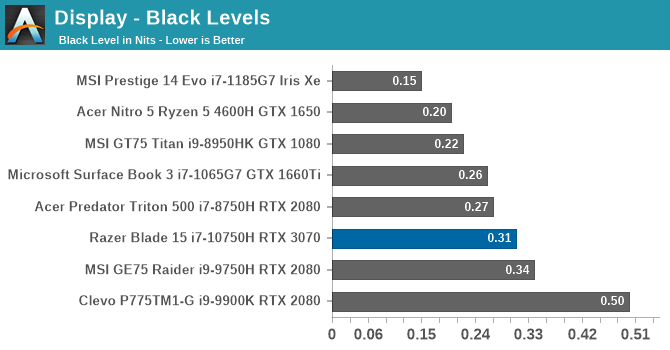
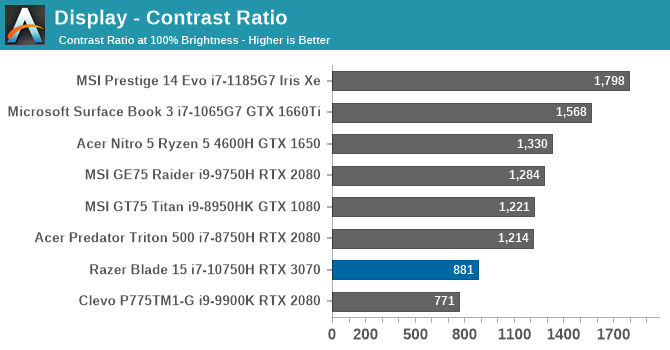
The QHD model of the Razer Blade 15 Base model does not go overly bright, at but 276 nits, and the contrast is very poor compared to the best IPS displays effectually, which tend to average around 1500:ane or better. This is not just a part of the display beingness a 165 Hz panel either, as nosotros have tested other high-refresh displays that practise significantly ameliorate, at least in terms of dissimilarity ratio.
Grayscale
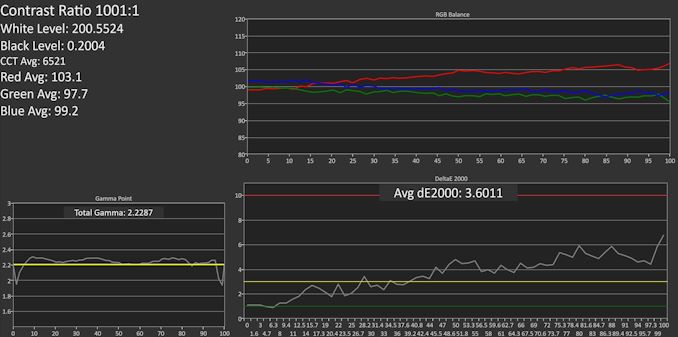 Portrait Displays Calman
Portrait Displays Calman
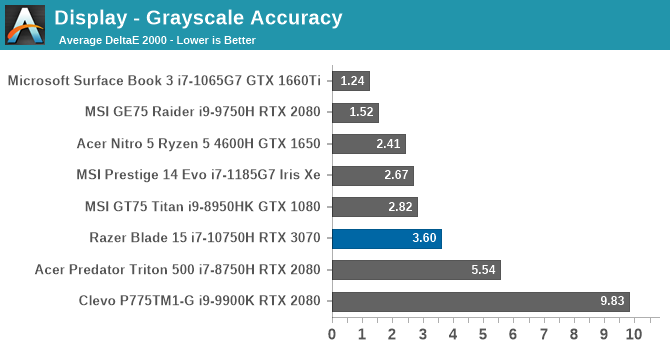
With Razer claiming that the displays are calibrated individually, hopes were high for solid results on the grayscale testing, merely while good, information technology is not bang-up. Gamma was very apartment though, merely the red values were quite high compared to blue and light-green. To ostend, this was tested with the ICC profile selected, equally bypassing information technology fabricated the display tilt very heavily towards greenish.
Gamut
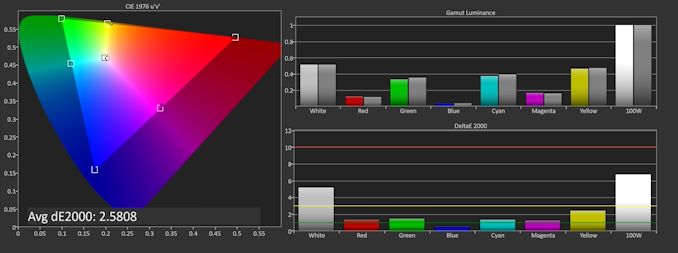 Portrait Displays Calman
Portrait Displays Calman
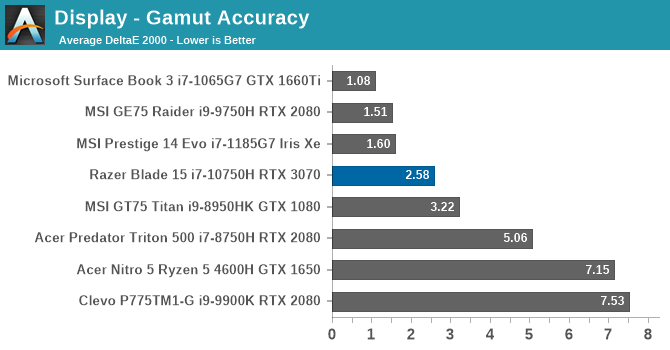
Every bit far as the primary and secondary color accuracy, with the caveat that this display is targeting the P3 D65 gamut, and not normal sRGB, Razer has washed a great job. They pretty much hit all of the 100% levels for all of the main colors, with xanthous beingness the weakest issue in the secondary range.
Saturation
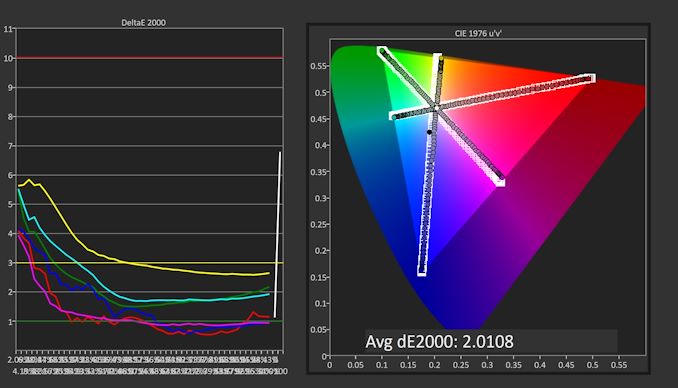 Portrait Displays Calman
Portrait Displays Calman
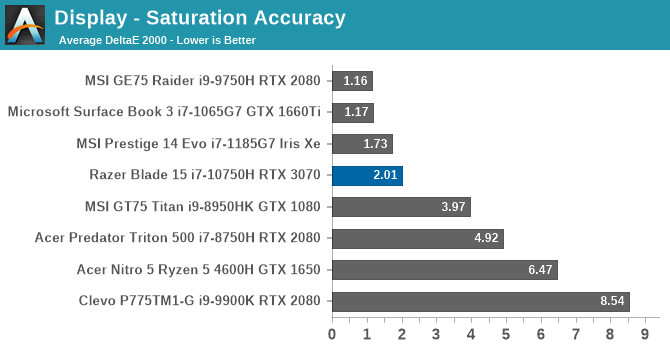
While the gamut test plots the results at the 100% levels for the master and secondary colors, the saturation test steps through at iv-fleck increments from 0% to 100% on each color. While non quite as accurate at low intensity, the colors all fall nether the three.0 error level that we would consider to be a expert outcome by the time they hit about 40% brightness.
Gretag Macbeth
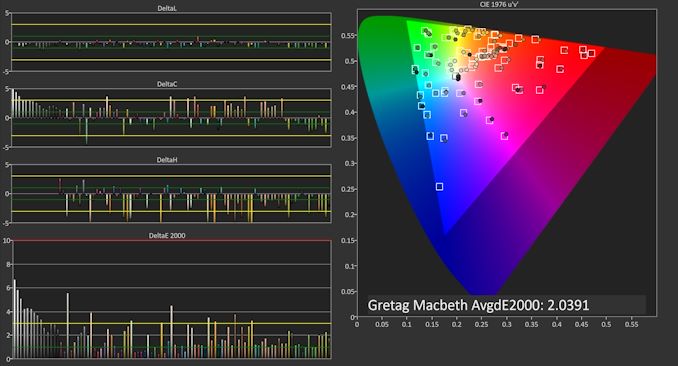 Portrait Displays Calman
Portrait Displays Calman
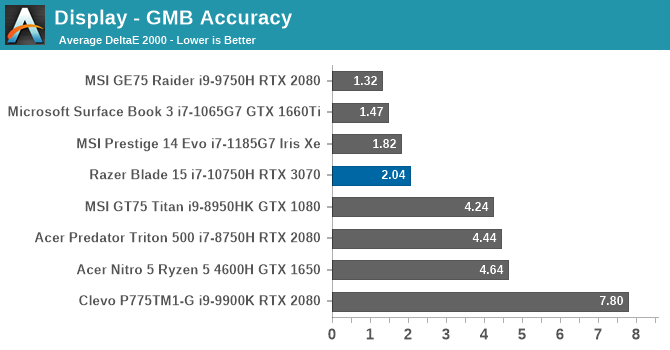
The final sampling is the Gretag Macbeth exam, which tests a multifariousness of color points, rather than just on the primary and secondary color axis, including the important pare tones. While a few colors did have error levels that were excessive, on boilerplate, the display did a great task of hitting most of the color points with very loftier accuracy.
Colorchecker
 Portrait Displays Calman
Portrait Displays Calman
Finally, to requite a relative error level, this colorchecker swatch displays the targeted color on the bottom, and what the display produced on the top. It is relative though because any fault levels in your own display will cause an get-go, but information technology does practice a dandy job showcasing what the other tests displayed. On the whites and grays, the Razer Bract xv is too far into the reds, but on the colors themselves, the display is in fact very authentic.
Brandish Determination
Gaming laptops may not be the devices where people crave hyper-accurate displays, just on premium devices, you lot should expect that the manufacturer has provided at to the lowest degree a reasonable caste of color-correction. Razer, despite using the less than platonic ICC color correction, has washed a good chore calibrating this display for well-nigh tasks. However, as a P3 D65 display, Windows 10 does tend to blow out pretty much everything you would want to display on it. Some people prefer that, so perchance this is done by design on the Razer Blade xv, just until such a time equally Windows provides a system-wide color management system, P3 gamuts will ever exist problematic.
The display does striking some highs though for its intended target. With a 2560x1440 resolution, the Razer Blade fifteen really fits the included GPU well, allowing for gaming at the native resolution without compromise on allegiance. It feels like the RTX 3070 Laptop GPU really is the platonic GPU for such a system. Too, the 165 Hz refresh rate adds smoothness to the gaming feel that makes it very enjoyable. Otherwise, it would have been nice to see Razer offering G-SYNC across the lath, which would have also enabled Avant-garde Optimus to remove the pain point of rebooting when switching the display multiplexer, but fifty-fifty with "but" a hardware multiplexer for switching between Optimus and straight dGPU way, it is still a bang-up organisation for its intended owner.
burleythenswithe1969.blogspot.com
Source: https://www.anandtech.com/show/16528/the-razer-blade-15-review-amped-up-with-ampere/4
0 Response to "How Do You Know Which Panel You Have Razer Blade"
Postar um comentário